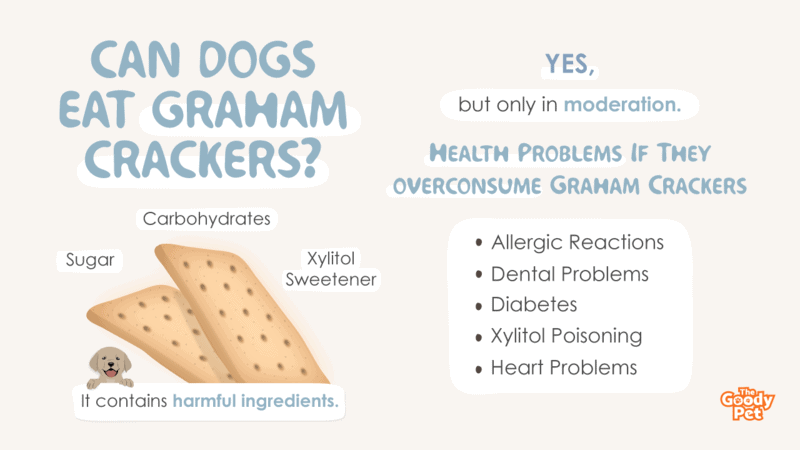Do you ever give your dog a Graham Cracker as a treat? Dogs love the taste of these sweet, crunchy snacks, but are they safe for Fido to eat? As much as our furry friends may enjoy the taste of Graham Crackers, it’s important to remember that these sweet treats are not meant for dogs.
Dogs can eat Graham Crackers, but only in moderation. This is because Graham Crackers contain sugar, carbohydrates, and chocolate chips, all of which can be harmful to dogs if consumed in large amounts, leading to vomiting and diabetes. Also, the packaging of Graham Crackers can pose a choking hazard for dogs.
In this blog post, we’ll explore the potential effects of incorporating Graham Crackers into your pup’s diet. So if you’re wondering whether your furry friend can enjoy a few Graham Crackers with you, read on! First, we’ll start by reviewing a potentially harmful sweetener in Graham Crackers.
Do Graham Crackers Contain Xylitol?

Many people are surprised to learn that Graham Crackers do contain xylitol. This sugar alcohol is found in various plant-based foods, including corn syrup and honey.
While it’s perfectly safe for humans to consume, xylitol can be very dangerous for dogs. Even a small amount of xylitol sweetener can cause dangerous and even fatal side effects.
Here’s a detailed list of possible reactions:
Lowered Blood Pressure
Xylitol may lower a dog’s blood pressure because it increases circulation. Xylitol dilates the blood vessels and increases blood flow, which can reduce blood pressure. Additionally, xylitol also has an anti-inflammatory effect, further reducing blood pressure.
Vomiting
The most common side effect of consuming xylitol is vomiting, which can occur within 30 minutes of ingestion. It is due to the water pulled off by xylitol reacting with intestinal bacteria and causing intoxication.
Lethargy
If your pup seems lethargic or sluggish, these may be side effects of xylitol, which reduces dogs’ blood pressure—lower blood pressure results in a tired and dizzy canine.
Depression
One of the most severe side effects of xylitol in dogs is depression. Xylitol can cause a drop in blood pressure, leading to feelings of fatigue and depression.
Seizures
Another common side effect is seizures. Seizures can occur between 15 to 30 minutes after a dog ingests xylitol and can last for up to 24 hours. In some cases, dogs experience multiple seizures over several days.
Seizures are caused by a sudden drop in blood sugar or hypoglycemia and can be fatal if not treated promptly.
Do Graham Crackers Give Dogs Diarrhea?

Yes, Graham Crackers can cause diarrhea in dogs. The xylitol and carbohydrates in Graham Crackers can upset a dog’s stomach and cause loose stools. If your dog just ate Graham Crackers, it’s crucial to monitor the stool quality of your furry friend.
What Happens If My Dog Eats Graham Crackers?
Besides this, our dogs may face other health problems if they consume Graham Crackers.
Allergic Reactions
Allergic reactions are the most common problem associated with Graham Crackers. Dogs can be allergic to wheat flour, milk, eggs, or other ingredients in Graham Crackers. Signs of an allergic reaction include itching, redness, swelling, hives, and difficulty breathing.
Dental Problems
Dental problems can also occur if your dog consumes Graham Crackers regularly. The sugar and carbohydrates in Graham Crackers can contribute to the development of plaque and tartar on your dog’s teeth. Over time, this can lead to gum disease and tooth decay.
Overweight
Obesity or weight gain are also potential problems for dogs who consume Graham Crackers regularly. The calories in Graham Crackers can add up quickly, leading to weight gain. This can put your dog at risk for developing joint problems, respiratory problems, and diabetes.
Heart Problems
Heart problems can also develop in dogs who consume Graham Crackers. The sugar and carbohydrates in Graham Crackers can lead to an increase in blood sugar levels. This can result in severe heart disease.
Diabetes
There’s a lot of sugar in Graham Crackers, leading to diabetes in dogs. When dogs overeat sugar, their pancreases have to work overtime to produce insulin, and eventually, the pancreas can’t keep up, causing diabetes.
Xylitol Poisoning
Xylitol poisoning is also a potential problem for dogs who consume Graham Crackers. Xylitol is a sugar alcohol used as a sweetener in many products, including Graham Crackers. Xylitol is toxic to dogs and can cause hypoglycemia, seizures, and even liver failure.
Will Honey Graham Crackers Hurt Dogs?
Graham Crackers hurting a dog depends on several factors, such as the size and health of your dog and the specific ingredients in the honey Graham Crackers. Some dogs may safely eat honey Graham Crackers without problems, while others may experience gastrointestinal distress or allergic reactions.
When giving your dog honey Graham Crackers, it is important to remember that moderation is key. Too many honey Graham Crackers can lead to weight gain and other health problems, so it is best only to give them as an occasional treat.
Can Graham Crackers Kill Dogs?
Your dog won’t die after eating Graham Crackers in a little or moderate amount. However, dogs that ingest a large amount of sugar may experience upset stomachs or diarrhea.
In rare cases, dogs who consume large amounts of molasses may develop Heinz body anemia, which can be fatal. So it’s best to keep an eye on your pup if they’ve gotten into the cookie jar!






